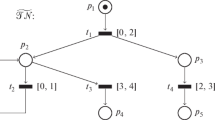Abstract
The stubborn-set method attempts to reduce the number of states that must be explicitly enumerated during reachability analysis of a concurrent system, while preserving crucial concurrency properties in the reduced state space. Here we extend the method to the analysis of certain timed models. We also prove that timing properties of interest, such as minimum and maximum delays between events, are preserved in the reduced model. Finally, we report on some experimental results that we have obtained with our extension. These results show that real-time stubborn sets can often provide significant reductions in state space size.
Similar content being viewed by others
References
B. Berthomieu and M. Diaz, “Modeling and verification of time dependent systems using time Petri nets,” IEEE Trans. Softw. Eng., Vol. 17, No. 3, pp. 259–273, March 1991
U. Buy and R. Sloan, “A Petri-net-based approach to real-time program analysis,” in Proc. Seventh Internat. Workshop on Software Specification and Design, pp. 56–60, Dec. 1993.
U. Buy and R.H. Sloan, “Automatic real-time analysis of Ada tasking programs for embedded systems,” Technical Report 95-1, Department of Electrical Engineering and Computer Science, University of Illinois at Chicago. Submitted for publication. May be obtained as http://www.eecs.uic.edu/Qbuy/buy12.ps.
U. Buy and R.H. Sloan, “Analysis of real-time programs with simple time Petri nets,” in Proc. 1994 Internat. Sympos. on Software Testing and Analysis, pp. 228–239, 1994.
J.C. Corbett and G.S. Avrunin, “A practical technique for bounding the time between events in concurrent real-time systems,” in Proc. 1993 Internat. Sympos. on Software Testing and Analysis, ACM, pp. 110–116, June 1993.
S. Duri, U. Buy, R. Devarapalli, and S.M. Shatz, “Application and experimental evaluation of state space reduction methods for deadlock analysis in Ada,” ACM Trans. Software Engineering and Methodology, Vol. 3, No. 4, pp. 340–380, Oct. 1994.
M.R. Garey and D.S. Johnson, Computers and Intractability: A Guide to the Theory of NP-Completeness, W.H. Freeman and Company, 1979.
C. Heitmeyer, R. Jeffords, and B. Labaw, “A benchmark for comparing different approaches for specifying and verifying real-time systems,” in Proc. Tenth Internat. Workshop on Real-Time Operating Systems and Software, May 1993.
F. Jahanian and D.A. Stuart, “A method for verifying properties of Modechart specifications,” in Proc. Real-Time Systems Sympos., pp. 12–21, Dec. 1988.
P.M. Merlin and D.J. Farber, “Recoverability of communication protocols-Implications of a theoretical study,” IEEE Trans. Communications, Vol. COM-24, No. 9, pp. 1036–1043, Sept. 1976.
T. Murata, “Petri nets: Properties, analysis and applications,” Proceedings of the IEEE, Vol. 77, No. 4, pp. 541–580, April 1989.
X. Nicollin, J. Sifakis, and S. Yovine, “Compiling real-time specifications into extended automata,” IEEE Trans. Softw. Eng., Vol. 18, No. 9, pp. 794–804, Sept. 1992.
J.L. Peterson, Petri Net Theory and the Modeling of Systems, Prentice-Hall, Inc., Englewood Cliffs, New Jersey, 1981.
R.H. Sloan and U. Buy, “Reduction rules for time Petri nets,” Acta Inf., Vol. 33, pp. 687–706, 1996 (in press).
A. Valmari, “Heuristics for lazy state generation speeds up analysis of concurrent systems,” in Proc. Finnish Artificial Intelligence Symposium, Helsinki, Finland, 1988, Vol. 2, pp. 640–650.
A. Valmari, “A stubborn attack on state explosion,” in E.M. Clarke and R.P. Kurshan (Eds.), Computer-Aided Verification: 2nd Internat. Conf., CAV '90, LNCS 531, Springer-Verlag, 1991, pp. 156–165.
T. Yoneda, A. Shibayama, B.-H. Schlingloff, and E.M. Clarke, “Efficient verification of parallel real-time systems,” in C. Courcoubetis (Ed.), Computer-Aided Verification: 5th Internat. Conf., CAV '93, LNCS 697, Springer-Verlag, 1993, pp. 321–332.
T. Yoneda and B.-H. Schlingloff, Efficient Verification of Parallel Real-Time Systems, unpublished manuscript, April 1996.
Author information
Authors and Affiliations
Rights and permissions
About this article
Cite this article
Sloan, R.H., Buy, U. Stubborn Sets for Real-Time Petri Nets. Formal Methods in System Design 11, 23–40 (1997). https://doi.org/10.1023/A:1008629725384
Issue Date:
DOI: https://doi.org/10.1023/A:1008629725384




